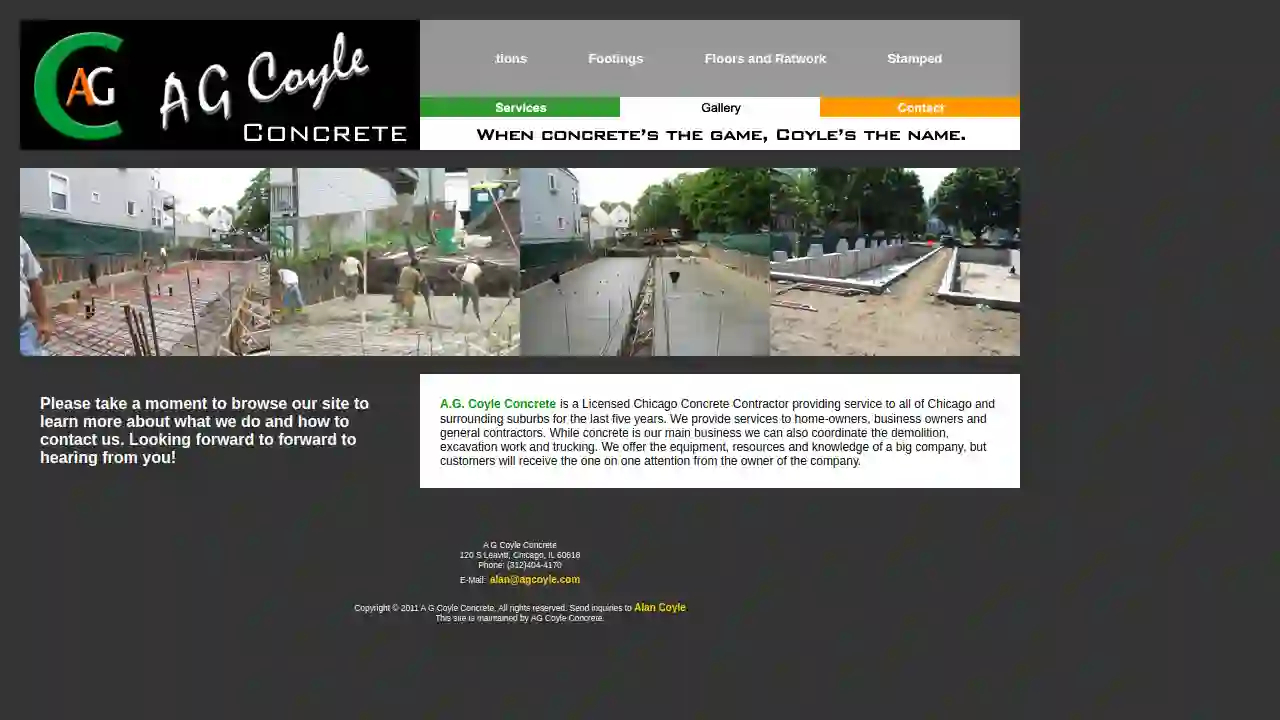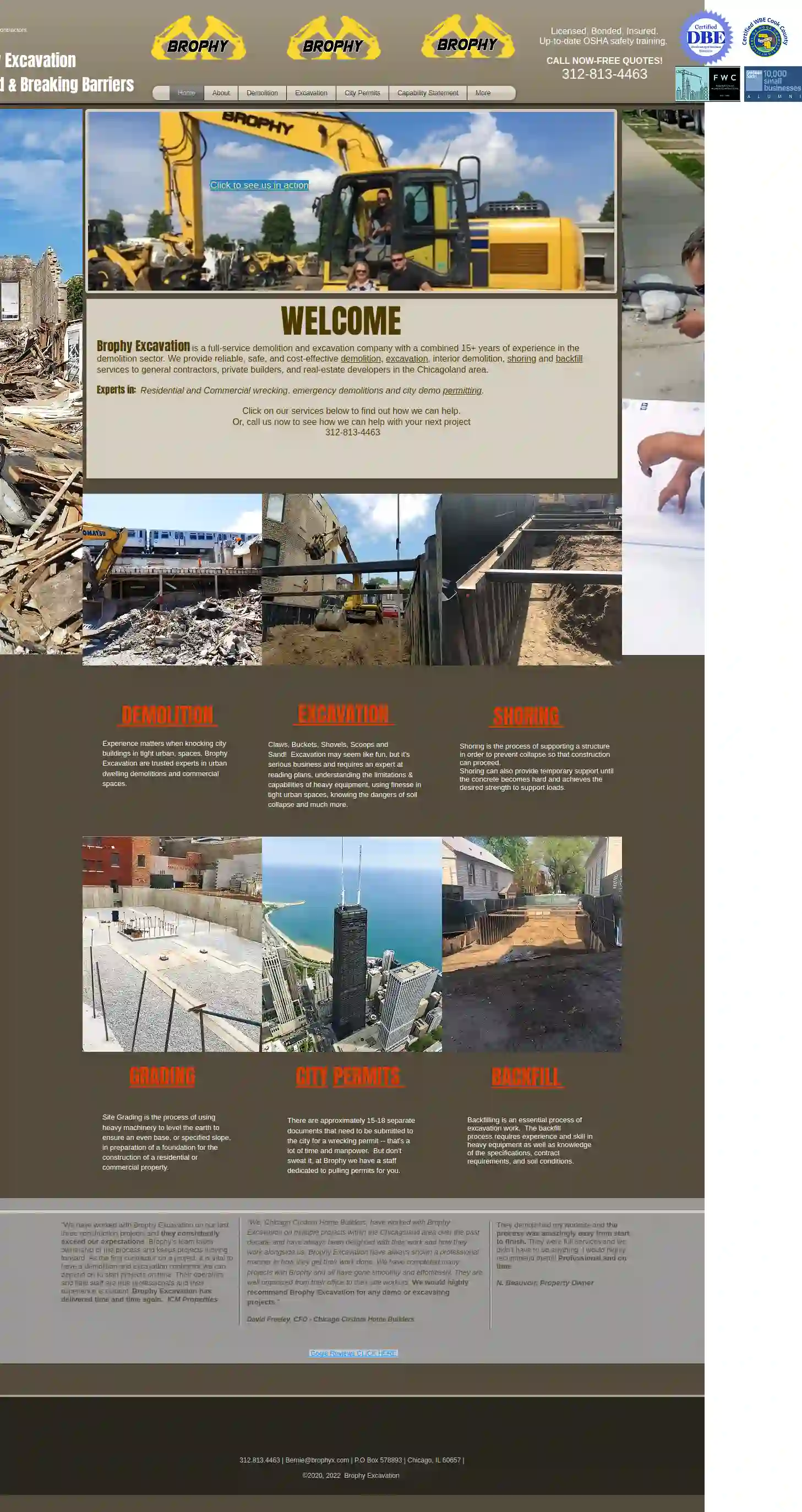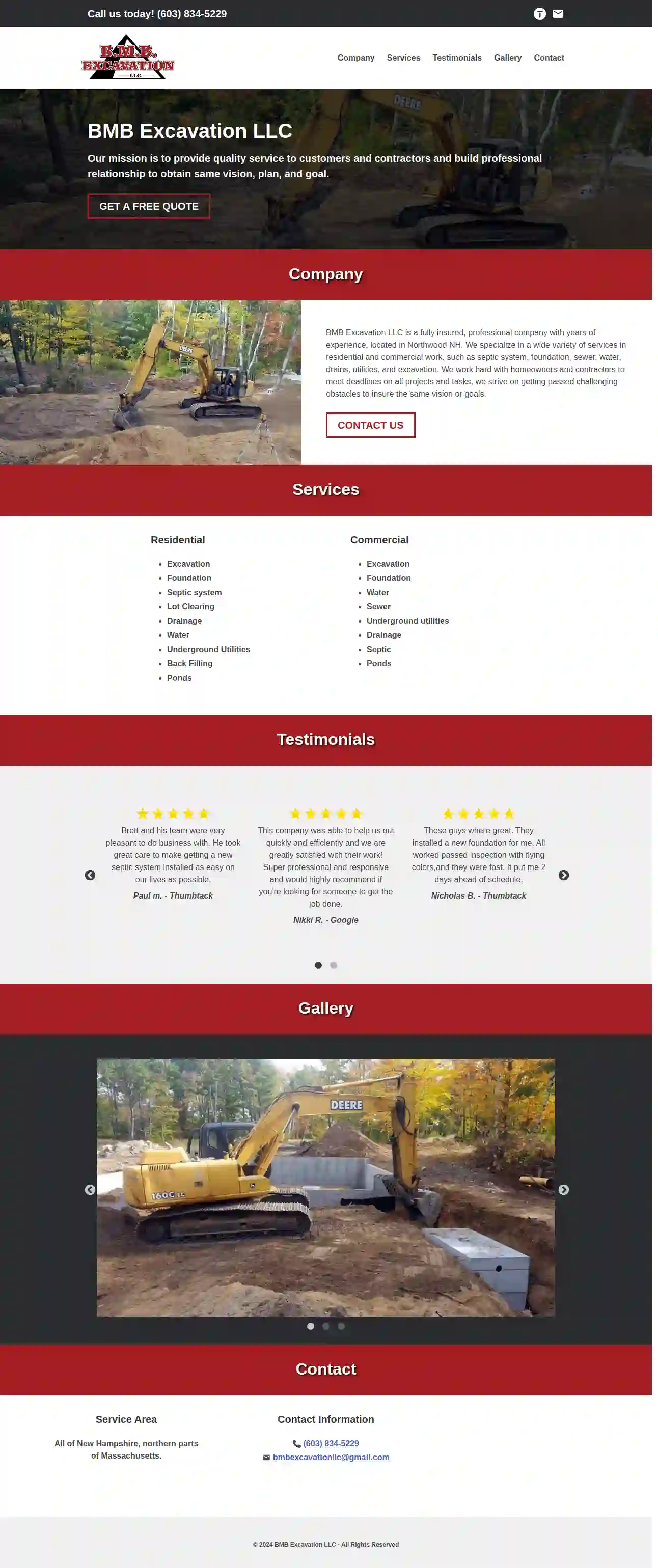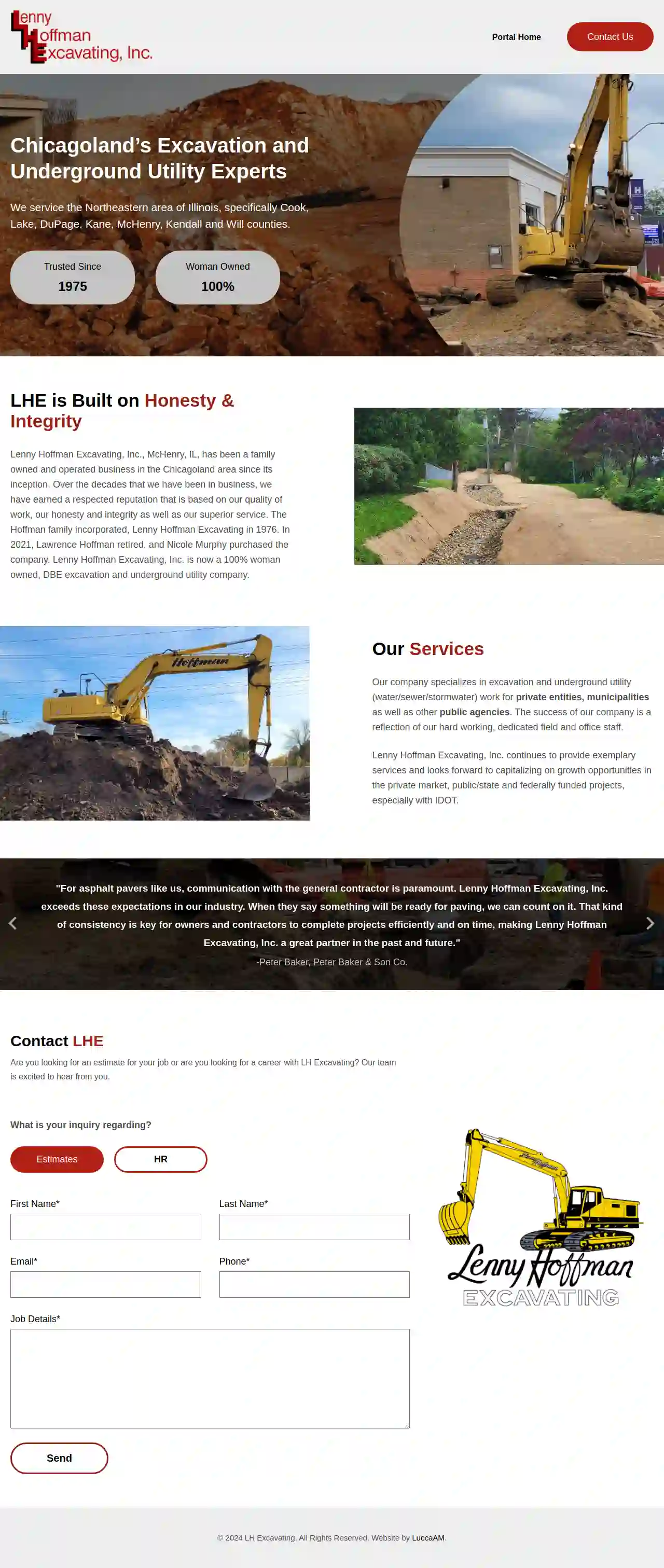Excavation Contractors Rockford
Find the best Excavating Contractor in Rockford
Get up to 3 Land Excavation quotes for your project today! Compare profiles, reviews, accreditations, portfolio, etc... and choose the best deal.
- Ry
Ryan Excavating
51 reviewsChicago, USFacebook is a social networking service and website launched in February 2004, owned by Meta Platforms. It is the largest social network in the world, with over 2.91 billion monthly active users as of the first quarter of 2023. Users can create a personal profile, add other users as friends, and exchange messages, photos, and videos. Facebook is also used by businesses to connect with customers and promote their products and services. The site has been criticized for its role in the spread of misinformation, its impact on mental health, and its privacy practices.
- Services
- Why Us?
- Gallery
Get Quote 
AG Coyle Concrete
1120 S Leavitt, Chicago, 60618, USA.G. Coyle Concrete: Your Trusted Chicago Concrete Contractor A.G. Coyle Concrete is a licensed and experienced Chicago concrete contractor serving the city and its surrounding suburbs for the past five years. We are dedicated to providing top-notch concrete services to homeowners, business owners, and general contractors alike. While concrete is our core expertise, we also offer a comprehensive range of services, including demolition, excavation, and trucking. We bring the resources and knowledge of a larger company, but with the personalized attention you'd expect from a family-owned business.
- Services
- Why Us?
- Gallery
Get Quote
Brophy Excavation-Demolition
4.86 reviewsP.O Box 578893, Chicago, 60657, USBrophy Excavation: Your Trusted Partner for Demolition and Excavation in Chicago Brophy Excavation is a full-service demolition and excavation company with over 15 years of experience in the Chicagoland area. We provide reliable, safe, and cost-effective services to general contractors, private builders, and real estate developers. Our team of experts is dedicated to delivering exceptional results on every project, no matter how big or small. We specialize in: Residential and Commercial Wrecking Emergency Demolitions City Demo Permitting Excavation Shoring Grading Backfill At Brophy Excavation, we understand the importance of safety and efficiency. We are fully licensed, bonded, and insured, and our team is up-to-date on all OSHA safety training. We are committed to providing our clients with the highest level of service and professionalism. Contact us today for a free quote and let us help you with your next project.
- Services
- Why Us?
- Testimonials
- Gallery
Get Quote- La
Lake Excavation LLC
52 reviewsAlton, US- Services
- Why Us?
- Gallery
Get Quote 
BMB Excavation LLC
44 reviewsNorthwood, USBMB Excavation LLC BMB Excavation LLC is a fully insured, professional company with years of experience, located in Northwood NH. We specialize in a wide variety of services in residential and commercial work, such as septic system, foundation, sewer, water, drains, utilities, and excavation. We work hard with homeowners and contractors to meet deadlines on all projects and tasks, we strive on getting passed challenging obstacles to insure the same vision or goals. Our mission is to provide quality service to customers and contractors and build professional relationship to obtain same vision, plan, and goal.
- Services
- Why Us?
- Testimonials
- Gallery
Get Quote
Accelerated Excavation
511 reviews1202 S Court St, Marion, IL, 62959, USWho we are Accelerated Excavation is a premier excavation service provider specializing in municipality, commercial, and residential projects. With a team of highly skilled professionals and state-of-the-art equipment, we deliver top-quality excavation solutions tailored to meet the unique needs of each project. Who we work with Real estate developers General contractors Homeowners & Business Owners Engineers Utility Companies Municipalities Government Agencies Our mission Provide reliable, efficient, and safe excavation services, ensuring every project is completed on time and to the highest standards. We are committed to excellence, customer satisfaction, and environmentally responsible practices, making us the trusted partner for all your excavation needs. Why Customers Choose Accelerated Excavation Safety First: Strict adherence to safety protocols on every job site Trained Team: Skilled & trained contractors with years of industry experience On Time, Everytime: Projects completed on schedule, every time Advanced Equipment: State-of-the-art machinery for precise and efficient excavation
- Services
- Why Us?
- Testimonials
- Gallery
Get Quote
F.L. Merrill Construction, Inc.
51 reviews35 Veterans Drive, Loudon, 03275, USProudly Serving New Hampshire Since 1990. Located In Loudon, NH Family Owned & Operated NH Construction Company Get A Quote Municipal Construction We specialize in road construction for small local subdivisions. Our expertise includes building, constructing, & repairing roadways. Commercial Construction Our New Hampshire commercial construction experience includes land clearing, site work, utility installation, and more. Residential Construction Whether you need help with excavation for a new septic system or any other excavation need, our team has 25+ years of experience. Who We Are A Dedicated Team Of Construction Experts F.L. Merrill Construction's success is built on a foundation of hard work and dedication, values that are shared by everyone from upper management to construction crew members. Frank and Sue Merrill realized their ability to provide customers with a superior service comes down to their team who are consider to be an extension of their family. By investing in its people, Merrill Construction has established itself as a NH construction industry leader for over three decades. Tell us about your project! Land Clearing Site Work Utility Installation Road Construction Bridge Construction Footing Foundations Residential Excavation Materials Supply Trucking & Dumping Get A Free Quote Today! Get A Quote
- Services
- Why Us?
- Testimonials
- Gallery
Get Quote
Lenny Hoffman Excavating Inc
4.17 reviewsMcHenry, USChicagoland’s Excavation and Underground Utility Experts We service the Northeastern area of Illinois, specifically Cook, Lake, DuPage, Kane, McHenry, Kendall and Will counties. Trusted Since 1975 Woman Owned 100% LHE is Built on Honesty & Integrity Lenny Hoffman Excavating, Inc., McHenry, IL, has been a family owned and operated business in the Chicagoland area since its inception. Over the decades that we have been in business, we have earned a respected reputation that is based on our quality of work, our honesty and integrity as well as our superior service. The Hoffman family incorporated, Lenny Hoffman Excavating in 1976. In 2021, Lawrence Hoffman retired, and Nicole Murphy purchased the company. Lenny Hoffman Excavating, Inc. is now a 100% woman owned, DBE excavation and underground utility company. Our Services Our company specializes in excavation and underground utility (water/sewer/stormwater) work for private entities, municipalities as well as other public agencies. The success of our company is a reflection of our hard working, dedicated field and office staff. Lenny Hoffman Excavating, Inc. continues to provide exemplary services and looks forward to capitalizing on growth opportunities in the private market, public/state and federally funded projects, especially with IDOT. Testimonials "For asphalt pavers like us, communication with the general contractor is paramount. Lenny Hoffman Excavating, Inc. exceeds these expectations in our industry. When they say something will be ready for paving, we can count on it. That kind of consistency is key for owners and contractors to complete projects efficiently and on time, making Lenny Hoffman Excavating, Inc. a great partner in the past and future." -Peter Baker, Peter Baker & Son Co. "Alliance Contractors, Inc and Lenny Hoffman Excavating have been working together for more than 30 years. Whether ACI is working for Lenny Hoffman as a subcontractor or they are a subcontractor to ACI, we have been nothing but pleased with their team’s ability to outperform the industry standards on each and every project." -Bradley A. Spiniolas, Alliance Contractors, Inc.
- Services
- Why Us?
- Testimonials
- Gallery
Get Quote
4 Seasons Excavation
51 reviewsAuburn, New Hampshire, United States, USDig Deep, Build Strong Your trusted excavating contractor for all your residential and commercial needs. About 4 Seasons Excavation 4 Seasons Excavation is a team of excavation contractors who specialize in a variety of excavation services, including land clearing, grading, and excavation for new construction. Our team has the knowledge and expertise to ensure that every project is completed safely, on time, and within budget. Our Approach At 4 Seasons Excavation, we take a collaborative approach to every project. We work closely with our clients to ensure that their needs and goals are met, and we communicate clearly and transparently throughout the entire process. We believe that this approach leads to better outcomes and more satisfied customers.
- Services
- Why Us?
- Gallery
Get Quote
Witech Excavating
3.29 reviewsChicago, USA History of Strong Relationships Since our humble beginnings in 2001 as a small excavating and trucking company, we’ve continued to grow by building strong relationships. We’re always looking for new ways to provide better services to our clients and community. With our experienced personnel and extensive fleet of equipment, we have the resources to pass along the benefits to our customers. With competitive costs and knowledgeable employees, Witech provides superior responsiveness on all our projects. Although, the benefits don’t stop there. This level of control allows us to live up to our core values of integrity and honesty. Ultimately, when we say we’re going to do something, our clients know we mean it. Watch our Overview Video
- Services
- Why Us?
- Gallery
Get Quote
Over 3,943+ Excavation Companies on our directory
Our excavation companies operate in Rockford and surroundings!
ExcavationHQ has curated and vetted Top Excavation Contractors in Rockford. Find a trustworthy pro today.
Frequently Asked Questions About Excavation Contractors
- Clearly Define the Scope: Outline the project's goals, including the excavation area, depth, grade, and intended use.
- Obtain Necessary Permits: Research and acquire any required permits from your local authorities.
- Mark Utility Lines: Contact your utility companies to locate and mark underground utilities to prevent damage.
- Communicate with Neighbors: Inform your neighbors about the project's timeline and potential noise or disruptions.
- Prepare the Site: Clear any obstacles, such as vegetation, furniture, or structures, from the excavation area.
- Discuss Safety Protocols: Review safety procedures with the contractor to ensure a safe work environment.
- Experience: Choose contractors with a proven track record and years of experience in excavation projects similar to yours.
- Licensing and Insurance: Verify that they are properly licensed to operate in your area and carry adequate insurance to protect you from liability in case of accidents or damage.
- Equipment and Resources: Ensure they have the necessary equipment and resources to handle your project efficiently and safely.
- Positive Reviews and References: Check online reviews and testimonials from previous customers. Request references and contact them to inquire about their experience with the contractor.
- Professionalism: Opt for a company that communicates clearly, provides detailed and transparent estimates, and has a responsive and courteous team.
- Excavators: Versatile machines with a bucket, arm, and rotating cab for digging, lifting, and moving earth.
- Backhoes: Similar to excavators but with a digging bucket on the back and a loader bucket on the front, ideal for trenching and smaller excavations.
- Bulldozers: Powerful machines with a large blade for pushing earth, clearing land, and leveling surfaces.
- Skid Steers: Compact and maneuverable loaders with various attachments (buckets, forks) for digging, loading, and grading in tight spaces.
- Trenchers: Specialized machines for digging narrow trenches for utilities.
- Dump Trucks: Vehicles for hauling excavated material to disposal sites.
- Trench Collapses: Unstable trench walls can cave in, posing a severe risk to workers. Proper shoring and sloping are crucial safety measures.
- Utility Damage: Striking underground utilities (gas, water, electric) can cause leaks, explosions, or electrocution. Accurate utility locates and careful digging are essential.
- Falling Objects: Materials or equipment falling into excavations can injure workers. Securing work areas and using appropriate safety gear is vital.
- Equipment Accidents: Operating heavy machinery involves risks of rollovers, collisions, or mechanical failures. Trained operators and proper equipment maintenance are critical.
- Environmental Hazards: Excavated soil might contain hazardous materials (asbestos, lead). Proper testing and disposal procedures are necessary.
What should I do before excavation starts?
How do I find a good excavation contractor?
What equipment is used for excavation?
What are the risks associated with excavation?
What should I do before excavation starts?
- Clearly Define the Scope: Outline the project's goals, including the excavation area, depth, grade, and intended use.
- Obtain Necessary Permits: Research and acquire any required permits from your local authorities.
- Mark Utility Lines: Contact your utility companies to locate and mark underground utilities to prevent damage.
- Communicate with Neighbors: Inform your neighbors about the project's timeline and potential noise or disruptions.
- Prepare the Site: Clear any obstacles, such as vegetation, furniture, or structures, from the excavation area.
- Discuss Safety Protocols: Review safety procedures with the contractor to ensure a safe work environment.
How do I find a good excavation contractor?
- Experience: Choose contractors with a proven track record and years of experience in excavation projects similar to yours.
- Licensing and Insurance: Verify that they are properly licensed to operate in your area and carry adequate insurance to protect you from liability in case of accidents or damage.
- Equipment and Resources: Ensure they have the necessary equipment and resources to handle your project efficiently and safely.
- Positive Reviews and References: Check online reviews and testimonials from previous customers. Request references and contact them to inquire about their experience with the contractor.
- Professionalism: Opt for a company that communicates clearly, provides detailed and transparent estimates, and has a responsive and courteous team.
What equipment is used for excavation?
- Excavators: Versatile machines with a bucket, arm, and rotating cab for digging, lifting, and moving earth.
- Backhoes: Similar to excavators but with a digging bucket on the back and a loader bucket on the front, ideal for trenching and smaller excavations.
- Bulldozers: Powerful machines with a large blade for pushing earth, clearing land, and leveling surfaces.
- Skid Steers: Compact and maneuverable loaders with various attachments (buckets, forks) for digging, loading, and grading in tight spaces.
- Trenchers: Specialized machines for digging narrow trenches for utilities.
- Dump Trucks: Vehicles for hauling excavated material to disposal sites.
What are the risks associated with excavation?
- Trench Collapses: Unstable trench walls can cave in, posing a severe risk to workers. Proper shoring and sloping are crucial safety measures.
- Utility Damage: Striking underground utilities (gas, water, electric) can cause leaks, explosions, or electrocution. Accurate utility locates and careful digging are essential.
- Falling Objects: Materials or equipment falling into excavations can injure workers. Securing work areas and using appropriate safety gear is vital.
- Equipment Accidents: Operating heavy machinery involves risks of rollovers, collisions, or mechanical failures. Trained operators and proper equipment maintenance are critical.
- Environmental Hazards: Excavated soil might contain hazardous materials (asbestos, lead). Proper testing and disposal procedures are necessary.